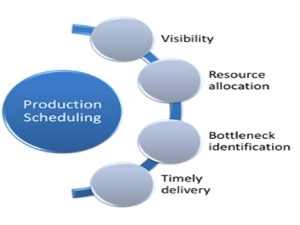
Selecting the right production scheduling software is crucial in the manufacturing industry, as production is the driving force to which other business functions react. Because selecting the best scheduling solution for your business can be deceivingly difficult, Ncoded Solutions has taken the time to share some of the important lessons it has learned over the last 20+ years in the hope that it might make it easier for you.
1. Understand your NEEDS and your CHALLENGES
As it is often hard to define what your business needs are when investing in a production planning and scheduling tool, it is much better to begin by focusing on fixing your major problems such as:
* Lack of visibility;
* Poor on-time delivery;
* High operating expenses and labour costs; and
* Long lead times.
According to author Oliver W Wight, the two key challenges in production scheduling are priorities and capacity. In other words, "What should be done first" and "Who should do it".
Production planners must always understand what is happening on the shop floor at any given time. If they do not have proper visibility, they cannot identify problems and cannot take counter measures in time. Typical questions requiring visibility are:
* Will my production order be completed in time?
* How is my resource utilisation?
* What is the status of any production order or operation?
2. Create a functionality wish list. - How do I pick the best software?
When you are implementing a planning and scheduling software, automation and versatility are key. Many ERP software systems and planning software systems tend to provide too little of the capacity visibility and constraint flexibility that users need.
Below are some key aspects that can help you pick the best software:
(i) Know your objectives and requirements: ask yourself the most important things to solve with the planning and scheduling software. Knowing the key objectives in the beginning will help you zoom down the software that works for you. Does it meet your goals? Does it integrate to your existing ERP software? Can it pull the data that you need?
(ii) Versatility. Adaptability. Scalability. These three make up the best scheduling software for you. If your new planning software can address a variety of challenges, future and present planning constraints, and give you unlimited "what if" scenarios, then this software will work well with your production management, as well as scheduling. A scheduling system that is accurate is also one that adapts, as your business grows and changes.
(iii) Clear view of capability. You have to understand and see what is happening in your advanced planning and scheduling software. It is imperative that you, your planners, and other users, understand the models and graphics shown, and know how to work with the system to identify bottlenecks and orders that are in jeopardy.
(iv) Pro-active management. One of the most important factors in using scheduling software is knowing that your software can handle random factors and adapt actively. Real-time updates are needed when something unexpected happens. Your software needs to be manageable, and your planners should have the ability to work with it easily and update your schedule, always understanding the impact of their decisions on other orders and business metrics.
(v) Ease of use. After analysing all the factors that go into buying and using a scheduling software, one of the most important is how easy it will be for your planners to use the software. To evaluate this, the best way (and maybe only way) is to hands-on time using the system with your company's data loaded. A pilot or proof-of-concept project is usually the best way to go to ensure a successful project in the end.
3. Which vendor should you go with?
When you implement planning and scheduling software, it is easy to see big players such as Oracle, Microsoft, and SAP as the best option. The best way to choose the right software is to focus on your requirements.
Particularly focus your on top or key requirements. Study these requirements, so that you know them well. Then check vendor details and profiles to match your requirements to their software available.
Remove any vendor from the list:
* that doesn't meet your needs; and
* that duplicates the software being offered, unless you want to consider different resellers of the same software.
4. Research. Research. Research
Look at some of what some industry experts look at when comparing systems such as these.
* Total cost of ownership;
* Software implementation costs;
* Implementation risks;
* IT benefits and analysis;
* IT database; and
* Expertise and qualifications.
Acknowledgements & References
Juliana Tamayo, Choosing the Best Planning and Scheduling Software, 2016
Share